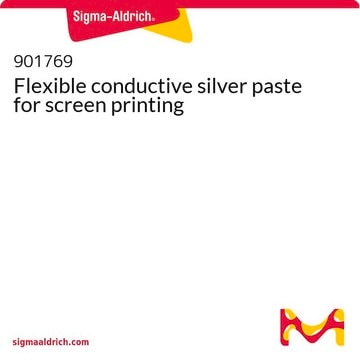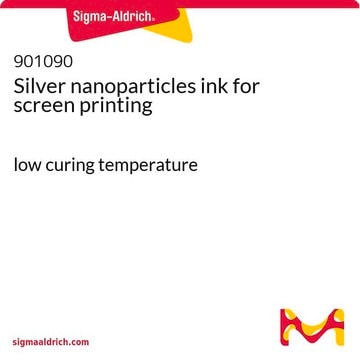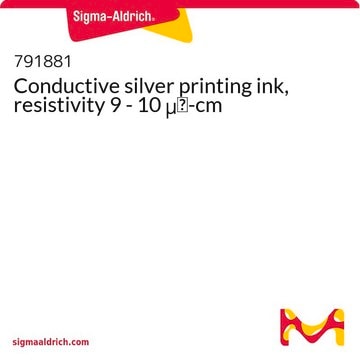735825
Silver
conductive paste
Sinonimo/i:
Silver Paste DGP80 TESM8020
About This Item
Prodotti consigliati
Forma fisica
paste (microparticles)
Caratteristiche più verdi
Design for Energy Efficiency
Learn more about the Principles of Green Chemistry.
sustainability
Greener Alternative Product
Concentrazione
≥75%
Resistività
1-3 * 10^-5 Ω-cm (conductive paste)
1.59 μΩ-cm, 20°C
Matrice
α-Terpineol
Dimensione particelle
200 nm (80%)
<5 nm (20%)
Viscosità
100,000-300,000 cP, 0.4 rpm(25 °C, Brookfield)
P. eboll.
2212 °C (lit.)
Punto di fusione
960 °C (lit.)
Temp. transizione
curing temperature 120-150 °C (30-60 min)
Densità
10.49 g/cm3 (lit.)
Categoria alternativa più verde
, Enabling
Temperatura di conservazione
2-8°C
Stringa SMILE
[Ag]
InChI
1S/Ag
BQCADISMDOOEFD-UHFFFAOYSA-N
Descrizione generale
Recommended washing solvent = polar solvent (Ethanol, IPA, Methanol, etc)
Recommended substrates = ITO film & glass, plastic film
Applicazioni
Note legali
Avvertenze
Danger
Indicazioni di pericolo
Consigli di prudenza
Classi di pericolo
Aquatic Acute 1 - Aquatic Chronic 1 - Eye Dam. 1 - Skin Irrit. 2
Codice della classe di stoccaggio
11 - Combustible Solids
Classe di pericolosità dell'acqua (WGK)
WGK 3
Punto d’infiammabilità (°F)
205.0 °F
Punto d’infiammabilità (°C)
96.1 °C
Certificati d'analisi (COA)
Cerca il Certificati d'analisi (COA) digitando il numero di lotto/batch corrispondente. I numeri di lotto o di batch sono stampati sull'etichetta dei prodotti dopo la parola ‘Lotto’ o ‘Batch’.
Possiedi già questo prodotto?
I documenti relativi ai prodotti acquistati recentemente sono disponibili nell’Archivio dei documenti.
I clienti hanno visto anche
Articoli
Small molecular weight organic semiconductors are promising for flexible transistor applications in next-gen soft electronics.
The diversity of applications and nanostructured materials accessible using ultrasonic spray methods are highlighted in this article.
While dye sensitization as the basis for color photography has been accepted for a very long time,1 attempts to use this principle for the conversion of solar light to electricity generally had resulted only in very low photocurrents, below 100 nA/cm
Ultrasonic spray pyrolysis produces scalable nanomaterials like metal oxides and quantum dots for diverse applications.
Il team dei nostri ricercatori vanta grande esperienza in tutte le aree della ricerca quali Life Science, scienza dei materiali, sintesi chimica, cromatografia, discipline analitiche, ecc..
Contatta l'Assistenza Tecnica.








